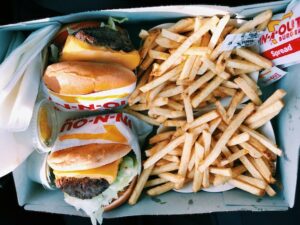
In-N-Out Burger’s business case reflects the significance of cultural alignment of the business to its market. The company is small compared to such giants as Burger King and Wendy’s. However, the per-store revenues of In-N-Out Burger strongly compete against the revenues of the larger companies. It is worth examining the factors in the relative success of In-N-Out Burger, particularly in how the company captures the hearts of its loyal customers and became part of the culture of Southern California. This regional success indicates business alignment with the characteristics of the Californian market, despite the company’s eventual expansion outside the state.
The Californian Market as In-N-Out Burger’s Stronghold
The market of In-N-Out Burger is characterized by the unique cultural composition of the population of California, especially southern California where the company has a stronghold. A high percentage of the population is composed of Asian Americans or Asian immigrants, as well as Latino Americans or Latino immigrants. In this regard, there is a diverse population in the state composed of whites, Asians, African-Americans and Latino Americans, along with other smaller minority groups. Such diversity in California’s consumer population is linked to successive waves of immigrants coming from various parts of the world, especially from Latin American and Asian countries.
This history of immigration resulted in a culture that is open to different kinds of perspectives as well as different preferences for various things, including food. Such openness and preference for variety are part of the focus and strengths of In-N-Out Burger. For example, even though its menu is relatively limited compared to the menu of other companies like Burger King and McDonald’s, In-N-Out Burger allows its customers to order variants of its products, thereby providing a considerable variety within a limited menu.
In buying and consuming food, customers have the tendency to focus on taste, convenience, and price, and the tendency to give lower priority to food products’ health effects. In-N-Out Burger takes advantage of this tendency by offering delicious and high quality food in the regional market. Even though the burger company considers the health effects of its products, it puts more emphasis on taste as a way of attracting its target customers.
The company’s view on product quality encompasses not just ingredients, but also the satisfaction of regional consumer preferences. Consumers flock to In-N-Out Burger stores based on the ability of the company’s products to match the preferences of different cultural groups in the region. For example, Latin American and Asian American consumers’ preference for spice is accounted for in the company’s food products.
The strong relationship between Californians and restaurants like In-N-Out Burger is due to the fact that the company provides products that satisfy the region’s consumers’ preference for spicy or non-bland food. In contrast, Burger King has relatively bland recipes compared to those of In-N-Out Burger. As a result, the food products of In-N-Out Burger stand out as an attractive option for Californian consumers.
From another perspective, the products in In-N-Out Burger’s relatively limited menu offering to the regional target market are a reflection of the unique blending of races, ethnicities, and cultures in the state. The mixture of spices and the combination of recipes in In-N-Out Burger reflect the various preferences of customers based on their racial, ethnic, and cultural backgrounds. In relation, the population of In-N-Out Burger’s store employees is diverse. This diversity directly represents California’s population diversity. However, considering its expansion beyond the state, the fast food chain now incorporates some of the preferences of target customers beyond the region.
In-N-Out Burger’s image includes its mom-and-pop ambience. This ambience provides a warm and familiar dining atmosphere that invites target customers. The fast food service business understands that its customers in California appreciate such an ambiance. For example, Asian Americans and Latin Americans are accustomed to having close-knit families. In recent years, In-N-Out Burger has made changes in its products to achieve higher flexibility in satisfying a diverse and growing consumer base as the business expands. However, the look and feel of the company’s restaurants remain a reflection of the warm environment that target customers prefer.
Expectations for the Future of In-N-Out Burger
In-N-Out Burger continues to be competitive despite the presence of large food service companies like Burger King and McDonald’s. In-N-Out Burger’s competitiveness puts emphasis on the strengths that the firm has reinforced over time as a result of effective business alignment with the cultural nuances of the target market, especially in California and neighboring states. Through consideration for the market’s cultural characteristics, In-N-Out Burgermaintains a strong presence and competitive business performance through the years.
Considering its expansion to states beyond its original target market in California, In-N-Out Burger positions its business as an increasingly strong player in the industry. The food service company still has a long way to grow to match the size and performance of large firms like McDonald’s, Wendy’s, Burger King, and Dunkin’. Nonetheless, its loyal customer base keeps In-N-Out Burger competitive. Also, the company’s continuing efforts to align its products to the spicy or non-bland preferences of customers attract a solid segment of the target market.
In-N-Out Burger might find it challenging to achieve rapid growth if its products specifically cater to certain tastes associated with Latin Americans and Asian Americans. This difficulty is based on the reality that consumers who prefer spicy foods are just a segment of the target market. To capture a bigger market share, In-N-Out Burger needs to consider modifying its recipes to cater to a bigger consumer population. However, doing so could shrink the company’s loyal customer base, which is a success factor in the fast food restaurant business.
References
- California Department of Parks and Recreation – Cultural California.
- In-N-Out Burger – Locations.
- In-N-Out Burger – Menu.
- Perman, S. (2009). In-N-Out Burger: A Behind-the-Counter Look at the Fast-Food Chain that Breaks all the Rules. Harper Business.
- United States Census Bureau – Quick Facts: California.
